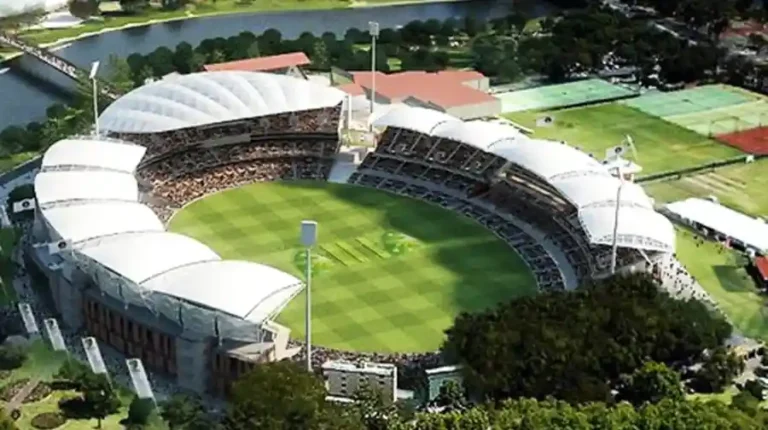Adelaide Oval, situated in North Adelaide, South Australia, stands as one of cricket’s most iconic venues. Established in 1873, it has been the stage for numerous historic matches and is celebrated for its picturesque setting and distinctive playing surface.
Stadium Overview
- Location: War Memorial Drive, North Adelaide, SA, 5006
- Established: 1873
- Seating Capacity: Approximately 53,500
- Primary Uses: Cricket and Australian Rules Football; also hosts rugby, soccer, tennis, and concerts.
- Ends: River End and Cathedral End
- Boundary Distances:
- Square Boundaries: 57–67 meters
- Straight Boundaries: 79–88 meters
Pitch Characteristics
The Adelaide Oval pitch is renowned for offering a balanced contest between bat and ball, with distinct behaviors observed across different formats and match durations.
General Behavior
- Early Stages: Fast bowlers benefit from the pitch’s consistent bounce and pace, making it challenging for batters initially.
- As the Match Progresses: The surface tends to wear, bringing spinners into play with increased turn and variable bounce.
- Day/Night Matches: Under lights, especially in day/night games, the ball is known to swing more, posing additional challenges for batters.
Format-Specific Insights
- Test Matches:
- First Innings: The pitch is generally favorable for batting, allowing teams to post substantial totals.
- Later Innings: Deterioration of the surface offers assistance to spinners, making batting progressively challenging.
- One-Day Internationals (ODIs):
- First Innings: Teams often aim for scores around the average first innings score of 225, with the highest recorded total being 369/7 by Australia against Pakistan.
- Second Innings: Chasing can be demanding under lights due to increased swing; however, successful chases have been recorded, with the highest being 303/9 by Sri Lanka against England.
- Twenty20 Internationals (T20Is):
- High-Scoring Venue: The pitch’s true nature and shorter square boundaries contribute to high-scoring encounters, with an average first innings score of 158 and the highest total being 241/4 by Australia against the West Indies.
Historical Records and Statistics
Test Matches
| Total Matches Hosted | Matches Won Batting First | Matches Won Batting Second | Draws/No Results | Average First Innings Score |
|---|---|---|---|---|
| 85 | 41 | 24 | 20 | 379 |
One-Day Internationals
| Total Matches Hosted | Matches Won Batting First | Matches Won Bowling First | Average First Innings Score |
|---|---|---|---|
| 94 | 49 | 43 | 225 |
Twenty20 Internationals
| Total Matches Hosted | Matches Won Batting First | Matches Won Bowling First | Average First Innings Score |
|---|---|---|---|
| 19 | 10 | 8 | 158 |
Weather Conditions
- Hot, Dry Conditions: Accelerate pitch deterioration, enhancing spin.
- Overcast Conditions: Favor swing bowlers due to increased humidity.
- Day/Night Matches: Evening dew can affect both batting and bowling strategies.
Strategic Considerations for Teams
- Batting First: Generally advantageous due to favorable initial batting conditions and the potential for pitch deterioration.
- Spin Bowlers: Become increasingly effective as the match progresses, especially in longer formats.
- Pace Bowlers: Should exploit early movement and bounce, particularly under lights in day/night fixtures.
Conclusion
Adelaide Oval’s pitch offers a dynamic and evolving challenge, rewarding teams that adapt to its changing conditions. Its rich history and balanced nature make it a revered venue in international cricket.



